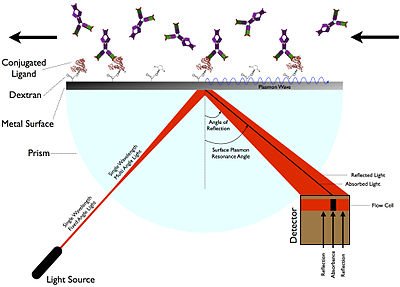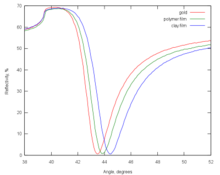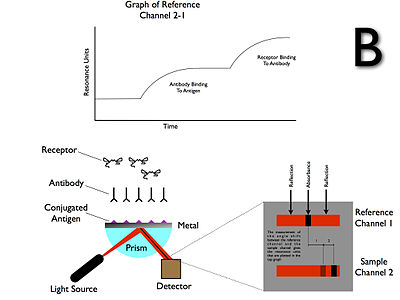Surface plasmon resonance: Difference between revisions
Undid revision 582510114 by Melanie gaillet (talk): spam |
|||
| Line 99: | Line 99: | ||
*{{cite book|author= Richard B M Schasfoort (Editor) and Anna J Tudos (Editor)| title= Handbook of Surface Plasmon Resonance| publisher=RSC publishing|year=2008|isbn=978-0-85404-267-8 }} |
*{{cite book|author= Richard B M Schasfoort (Editor) and Anna J Tudos (Editor)| title= Handbook of Surface Plasmon Resonance| publisher=RSC publishing|year=2008|isbn=978-0-85404-267-8 }} |
||
*[http://www.astbury.leeds.ac.uk/facil/SPR/spr_intro2004.htm A short detailed synopsis of how surface plasmon resonance works in practice] |
*[http://www.astbury.leeds.ac.uk/facil/SPR/spr_intro2004.htm A short detailed synopsis of how surface plasmon resonance works in practice] |
||
*[http://www.horiba.com/scientific/products/surface-plasmon-resonance-imaging-spri/ Introduction to SPR technique, SPRi systems, SPR-MS coupling] |
|||
{{refend}} |
{{refend}} |
||
Revision as of 14:17, 20 November 2013

Surface plasmon resonance (SPR) is the collective oscillation of electrons in a solid or liquid stimulated by incident light. The resonance condition is established when the frequency of light photons matches the natural frequency of surface electrons oscillating against the restoring force of positive nuclei. SPR in nanometer-sized structures is called localized surface plasmon resonance.[1]
SPR is the basis of many standard tools for measuring adsorption of material onto planar metal (typically gold and silver) surfaces or onto the surface of metal nanoparticles. It is the fundamental principle behind many color-based biosensor applications and different lab-on-a-chip sensors.
Explanation
Surface plasmon polaritons are surface electromagnetic waves that propagate in a direction parallel to the metal/dielectric (or metal/vacuum) interface. Since the wave is on the boundary of the metal and the external medium (air or water for example), these oscillations are very sensitive to any change of this boundary, such as the adsorption of molecules to the metal surface.
To describe the existence and properties of surface plasmon polaritons, one can choose from various models (quantum theory, Drude model, etc.). The simplest way to approach the problem is to treat each material as a homogeneous continuum, described by a frequency-dependent relative permittivity between the external medium and the surface. This quantity, hereafter referred to as the materials' "dielectric constant," is complex permittivity. In order for the terms which describe the electronic surface plasmons to exist, the real part of the dielectric constant of the metal must be negative and its magnitude must be greater than that of the dielectric. This condition is met in the IR-visible wavelength region for air/metal and water/metal interfaces (where the real dielectric constant of a metal is negative and that of air or water is positive).
LSPRs (Localized SPRs) are collective electron charge oscillations in metallic nanoparticles that are excited by light. They exhibit enhanced near-field amplitude at the resonance wavelength. This field is highly localized at the nanoparticle and decays rapidly away from the nanoparticle/dieletric interface into the dielectric background, though far-field scattering by the particle is also enhanced by the resonance. Light intensity enhancement is a very important aspect of LSPRs and localization means the LSPR has very high spatial resolution (subwavelength), limited only by the size of nanoparticles. Because of the enhanced field amplitude, effects that depend on the amplitude such as magneto-optical effect are also enhanced by LSPRs.[2][3]
Realization


In order to excite surface plasmons in a resonant manner, one can use an electron or light beam (visible and infrared are typical). The incoming beam has to match its momentum to that of the plasmon.[4] In the case of p-polarized light (polarization occurs parallel to the plane of incidence), this is possible by passing the light through a block of glass to increase the wavenumber (and the momentum), and achieve the resonance at a given wavelength and angle. S-polarized light (polarization occurs perpendicular to the plane of incidence) cannot excite electronic surface plasmons. Electronic and magnetic surface plasmons obey the following dispersion relation:
where is the dielectric constant, and is the magnetic permeability of the material (1: the glass block, 2: the metal film).
Typical metals that support surface plasmons are silver and gold, but metals such as copper, titanium or chromium have also been used.
When using light to excite SP waves, there are two configurations which are well known. In the Otto setup, the light illuminates the wall of a glass block, typically a prism, and is totally internally reflected. A thin metal film (for example gold) is positioned close enough to the prism wall so that an evanescent wave can interact with the plasma waves on the surface and hence excite the plasmons.
In the Kretschmann configuration, the metal film is evaporated onto the glass block. The light again illuminates the glass block, and an evanescent wave penetrates through the metal film. The plasmons are excited at the outer side of the film. This configuration is used in most practical applications.
SPR emission
When the surface plasmon wave interacts with a local particle or irregularity, such as a rough surface, part of the energy can be re-emitted as light. This emitted light can be detected behind the metal film from various directions.
Applications
Surface plasmons have been used to enhance the surface sensitivity of several spectroscopic measurements including fluorescence, Raman scattering, and second harmonic generation. However, in their simplest form, SPR reflectivity measurements can be used to detect molecular adsorption, such as polymers, DNA or proteins, etc. Technically, it is common, that the angle of the reflection minimum (absorption maximum) is measured. This angle changes in the order of 0.1° during thin (about nm thickness) film adsorption. (See also the Examples.) In other cases the changes in the absorption wavelength is followed.[5] The mechanism of detection is based on that the adsorbing molecules cause changes in the local index of refraction, changing the resonance conditions of the surface plasmon waves.
If the surface is patterned with different biopolymers, using adequate optics and imaging sensors (i.e. a camera), the technique can be extended to surface plasmon resonance imaging (SPRI). This method provides a high contrast of the images based on the adsorbed amount of molecules, somewhat similar to Brewster angle microscopy (this latter is most commonly used together with a Langmuir–Blodgett trough).
For nanoparticles, localized surface plasmon oscillations can give rise to the intense colors of suspensions or sols containing the nanoparticles. Nanoparticles or nanowires of noble metals exhibit strong absorption bands in the ultraviolet-visible light regime that are not present in the bulk metal. This extraordinary absorption increase has been exploited to increase light absorption in photovoltaic cells by depositing metal nanoparticles on the cell surface.[6] The energy (color) of this absorption differs when the light is polarized along or perpendicular to the nanowire.[7] Shifts in this resonance due to changes in the local index of refraction upon adsorption to the nanoparticles can also be used to detect biopolymers such as DNA or proteins. Related complementary techniques include plasmon waveguide resonance, QCM, extraordinary optical transmission, and dual polarization interferometry
SPR Immunoassay
The first SPR immunoassay was proposed in 1983 by Liedberg, Nylander, and Lundström, then of the Linköping Institute of Technology (Sweden).[8] They adsorbed human IgG onto a 600-angstrom silver film, and used the assay to detect anti-human IgG in water solution. Unlike many other immunoassays, such as ELISA, an SPR immunoassay is label free in that a label molecule is not required for detection of the analyte.[9]
Data interpretation
The most common data interpretation is based on the Fresnel formulas, which treat the formed thin films as infinite, continuous dielectric layers. This interpretation may result multiple possible refractive index and thickness values. However, usually only one solution is within the reasonable data range.
Metal particle plasmons are usually modeled using the Mie scattering theory.
In many cases no detailed models are applied, but the sensors are calibrated for the specific application, and used with interpolation within the calibration curve.
Examples
Layer-by-layer self-assembly

One of the first common applications of surface plasmon resonance spectroscopy was the measurement of the thickness (and refractive index) of adsorbed self-assembled nanofilms on gold substrates. The resonance curves shift to higher angles as the thickness of the adsorbed film increases. This example is a 'static SPR' measurement.
When higher speed observation is desired, one can select an angle right below the resonance point (the angle of minimum reflectance), and measure the reflectivity changes at that point. This is the so-called 'dynamic SPR' measurement. The interpretation of the data assumes that the structure of the film does not change significantly during the measurement.
Binding constant determination


When the affinity of two ligands has to be determined, the binding constant must be determined. It is the equilibrium value for the product quotient. This value can also be found using the dynamical SPR parameters and, as in any chemical reaction, it is the association rate divided by the dissociation rate.
For this, a so-called bait ligand is immobilized on the dextran surface of the SPR crystal. Through a microflow system, a solution with the prey analyte is injected over the bait layer. As the prey analyte binds the bait ligand, an increase in SPR signal (expressed in response units, RU) is observed. After desired association time, a solution without the prey analyte (usually the buffer) is injected on the microfluidics that dissociates the bound complex between bait ligand and prey analyte. Now as the prey analyte dissociates from the bait ligand, a decrease in SPR signal (expressed in resonance units, RU) is observed. From these association ('on rate', ka) and dissociation rates ('off rate', kd), the equilibrium dissociation constant ('binding constant', KD) can be calculated.
The actual SPR signal can be explained by the electromagnetic 'coupling' of the incident light with the surface plasmon of the gold layer. This plasmon can be influenced by the layer just a few nanometer across the gold–solution interface i.e. the bait protein and possibly the prey protein. Binding makes the reflection angle change;
Magnetic plasmon resonance
Recently, there has been an interest in magnetic surface plasmons. These require materials with large negative magnetic permeability, a property that has only recently been made available with the construction of metamaterials.
See also
References
- ^ Zeng, S.; Yong, Ken-Tye; Roy, Indrajit; Dinh, Xuan-Quyen; Yu, Xia; Luan, Feng (2011). "A review on functionalized gold nanoparticles for biosensing applications". Plasmonics. 6 (3): 491–506. doi:10.1007/s11468-011-9228-1.
- ^ González-Díaz, Juan B.; García-Martín, Antonio; García-Martín, José M.; Cebollada, Alfonso; Armelles, Gaspar; Sepúlveda, Borja; Alaverdyan, Yury; Käll, Mikael (2008). "Plasmonic Au/Co/Au nanosandwiches with Enhanced Magneto-Optical Activity". Small. 4 (2): 202–5. doi:10.1002/smll.200700594. PMID 18196506.
- ^ Du, Guan Xiang; Mori, Tetsuji; Suzuki, Michiaki; Saito, Shin; Fukuda, Hiroaki; Takahashi, Migaku (2010). "Evidence of localized surface plasmon enhanced magneto-optical effect in nanodisk array". Appl. Phys. Lett. 96 (8): 081915. Bibcode:2010ApPhL..96h1915D. doi:10.1063/1.3334726.
- ^ Zeng, Shuwen; Yu, Xia; Law, Wing-Cheung; Zhang, Yating; Hu, Rui; Dinh, Xuan-Quyen; Ho, Ho-Pui; Yong, Ken-Tye (2012). "Size dependence of Au NP-enhanced surface plasmon resonance based on differential phase measurement". Sensors and Actuators B: Chemical. 176: 1128. doi:10.1016/j.snb.2012.09.073.
- ^ Minh Hiep, Ha; Endo, Tatsuro; Kerman, Kagan; Chikae, Miyuki; Kim, Do-Kyun; Yamamura, Shohei; Takamura, Yuzuru; Tamiya, Eiichi (2007). "A localized surface plasmon resonance based immunosensor for the detection of casein in milk". Sci. Technol. Adv. Mater. 8 (4): 331. Bibcode:2007STAdM...8..331M. doi:10.1016/j.stam.2006.12.010.
{{cite journal}}:|format=requires|url=(help) - ^ Pillai, S.; Catchpole, K. R.; Trupke, T.; Green, M. A. (2007). "Surface plasmon enhanced silicon solar cells". J. Appl. Phys. 101 (9): 093105. Bibcode:2007JAP...101i3105P. doi:10.1063/1.2734885.
- ^ Locharoenrat, Kitsakorn; Sano, Haruyuki; Mizutani, Goro (2007). "Phenomenological studies of optical properties of Cu nanowires". Sci. Technol. Adv. Mater. 8 (4): 277. Bibcode:2007STAdM...8..277L. doi:10.1016/j.stam.2007.02.001.
{{cite journal}}:|format=requires|url=(help) - ^ Liedberg, Bo; Nylander, Claes; Lunström, Ingemar (1983). "Surface plasmon resonance for gas detection and biosensing". Sensors and Actuators. 4: 299. doi:10.1016/0250-6874(83)85036-7.
- ^ Rich, RL; Myszka, DG (2007). "Higher-throughput, label-free, real-time molecular interaction analysis". Analytical biochemistry. 361 (1): 1–6. doi:10.1016/j.ab.2006.10.040. PMID 17145039.
Further reading
- A selection of free-download papers on Plasmonics in New Journal of Physics
- Heinz Raether (1988). Surface plasmons on smooth and rough surfaces and on gratings. Springer Verlag, Berlin. ISBN 978-3-540-17363-2.
- Stefan Maier (2007). Plasmonics: Fundamentals and Applications. Springer. ISBN 978-0-387-33150-8.
- Richard B M Schasfoort (Editor) and Anna J Tudos (Editor) (2008). Handbook of Surface Plasmon Resonance. RSC publishing. ISBN 978-0-85404-267-8.
{{cite book}}:|author=has generic name (help) - A short detailed synopsis of how surface plasmon resonance works in practice






